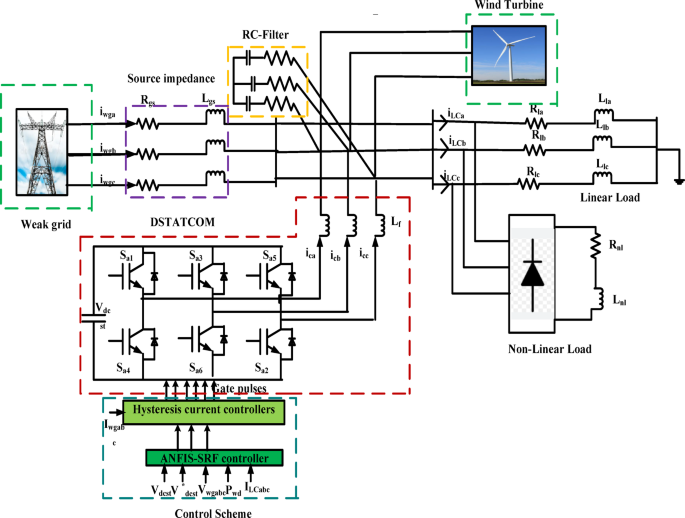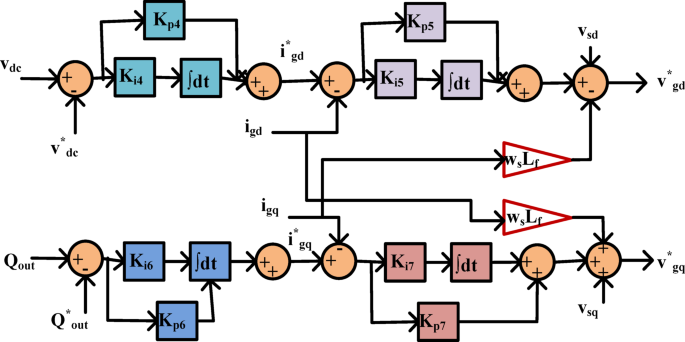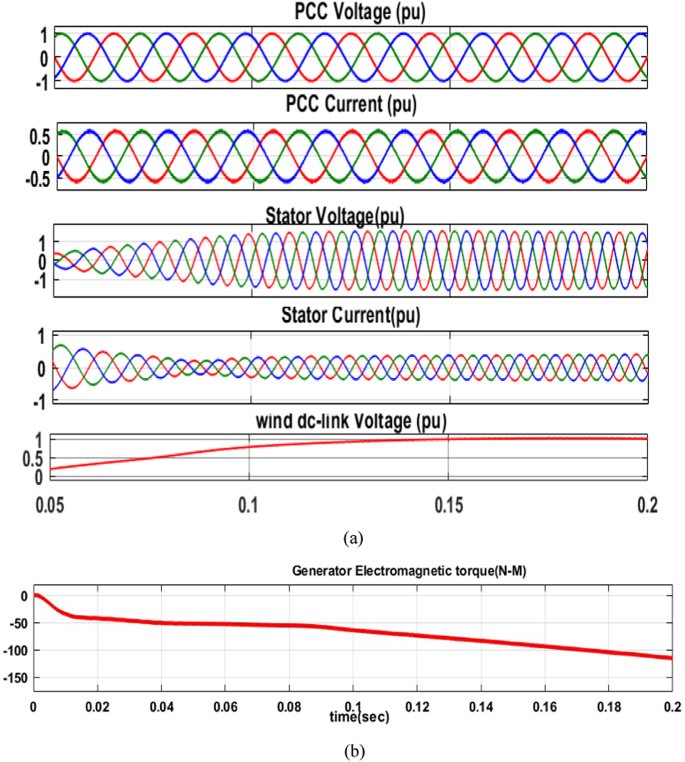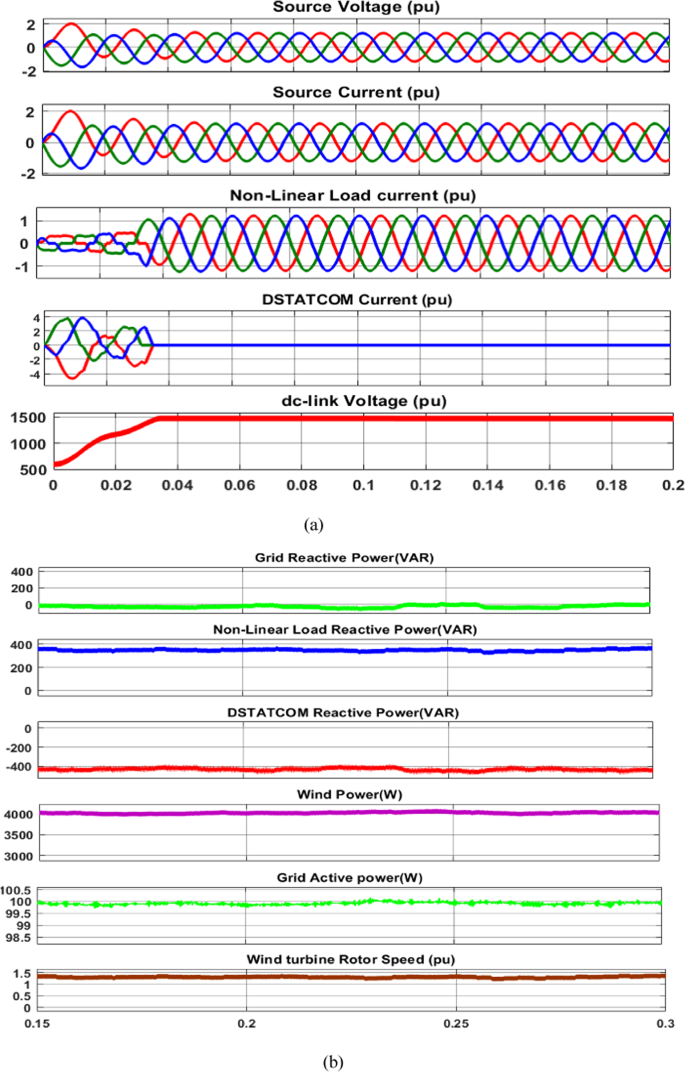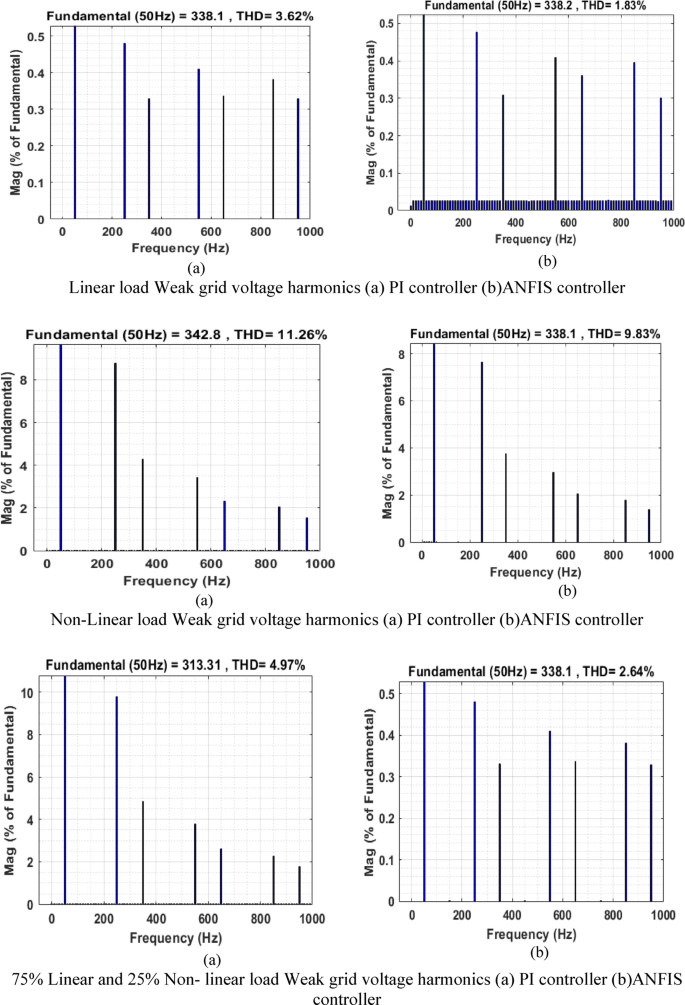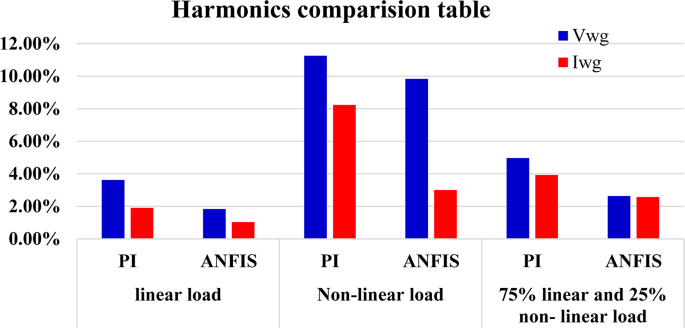Optimizing weak grid integrated wind energy systems using ANFIS-SRF controlled DSTATCOM
April 20, 2025
Abstract
This paper proposes an intelligent control strategy based on the adaptive neuro-fuzzy inference system (ANFIS) to enhance power quality in wind energy systems connected to weak grids. Weak grids, characterized by high impedance and low short-circuit ratios, suffer from voltage fluctuations, harmonic distortions, and reactive power imbalances when integrating wind energy. Conventional control methods, such as proportional-integral and fuzzy logic controllers, lack real-time adaptability, limiting their effectiveness in weak grid scenarios. The proposed ANFIS-based synchronous reference frame (SRF) control for a distribution static compensator (DSTATCOM) introduces an intelligent learning mechanism that dynamically adjusts reactive power compensation, harmonic mitigation, and voltage stabilization based on grid conditions. Unlike traditional approaches, the ANFIS-SRF controller leverages self-adaptive tuning and non-linear decision-making capabilities, ensuring superior system performance. The obtained simulations validate the effectiveness of the proposed method, demonstrating that grid voltage total harmonic distortion is reduced from 11.26 to 9.83% under non-linear load conditions and from 4.97 to 2.64% in mixed-load scenarios, maintaining compliance with IEEE 1547 and IEEE 519-2014 standards. Additionally, the power factor is significantly improved, reaching values above 0.98, while the proposed controller successfully maintains grid voltage and current stability under varying wind conditions. These numerical findings assures that the ANFIS-SRF-controlled DSTATCOM outperforms traditional control methods in ensuring reliable and efficient wind energy integration into weak grids. This study contributes to intelligent grid control applications by providing a self-learning, real-time adaptive solution that enhances grid stability, power quality, and renewable energy penetration.
Introduction
The growing demand for renewable energy is driven by the urgent need to reduce greenhouse gas emissions, combat climate change, and ensure long-term energy sustainability. As renewable energy sources such as wind, solar and hydro become a larger component of the global energy mix, grid operators face growing challenges in maintaining grid stability, reliability and power quality. Wind energy, in particular, has seen significant adoption worldwide due to its abundant, renewable, and low-cost characteristics. As the transition to renewable energy advances, the structure and operational stability requirements of the power grid are evolving. Most modern renewable energy sources are integrated into power systems via power electronic converters, resulting in a converter-dominated network. Consequently, this shift reduces the number of conventional synchronous power plants, leading to lower system inertia1. Renewable power plants are often located in rural areas with weak connections to load centres, which limits the capacity of renewable generation that can be integrated. Additionally, as the distance between renewable energy installations and power systems increases, longer transmission lines with higher equivalent impedance are required. This reduction in grid short-circuit current levels weakens the grid and significantly impacts its support mechanisms2. Thus, evaluating the frequency and voltage stability of such grids becomes crucial during both regular and disruptive operations. A weak grid refers to a power system with low short-circuit capacity, leading to increased voltage distortion and instability. In such environments, grid voltage feedforward control is crucial for managing inverter performance and suppressing current distortion caused by harmonics3. Integrating multiple grid-connected inverters in weak grids can lead to voltage instability and resonance issues. Implementing Novel grid-connected current feedback control helps mitigate these risks, improving overall system stability and performance4. In AC grids with weak characteristics, such as low short-circuit ratios and high penetration of renewable energy sources, the control dynamics of renewable energy systems can potentially trigger sub-synchronous oscillations5. The power synchronous control strategy effectively replicates the characteristics of a conventional synchronous generator while preserving the MPPT control capability of renewable energy systems. It also enables the self-synchronization of power generation without relying on a PLL, ensuring stable and reliable operation6. To address system instability caused by impedance variations in a weak grid, a capacitor current feedback active damping control method is proposed. Additionally, a grid voltage adaptive feedforward control strategy incorporating a front-end band-pass filter is introduced. This approach enhances system stability and mitigates grid harmonic disturbances by adaptively incorporating harmonic information into the voltage feedforward branch based on the specific content of each harmonic component7. The power injection capability of a wind energy (WE) source is approximately 20% in a strong grid8. However, in a grid with an SCR value of 2, it is reduced to 13% due to continuous variations in reactive power, voltage, frequency, and harmonics-based PQ disturbances. By implementing additional distribution static compensator (DSTATCOM) infrastructure at the point of connection (POC), the power injection capacity can be increased up to 30%. Researchers Favor such systems due to the benefits of individual wind energy (WE) systems in weak grids. Etxegarai et al.9 proposed that a supplementary static VAR compensator can help inject the necessary reactive power to mitigate power quality (PQ) issues. In this regard, the DSTATCOM rating is crucial for effective VAR management. However, determining the optimal DSTATCOM rating for low short-circuit ratio (SCR) grids remains a challenge for distribution operators. This rating depends on factors like connected loads, fault duration, grid codes, and reactive power requirements, with a recommended capacity ranging from 30 to 100% of the total WECS rating. To ensure precise estimation of reactive power at the point of connection (POC), a coordinated control scheme with accurate parameter calculations, considering system variations, is essential. Various control strategies have been explored in the literature. These include frequency-adaptive multistage harmonic oscillator control10, virtual capacitance control11, and hybrid generalized integrator control12, which focus on maintaining DC bus voltage and managing harmonics in weak grids, without accounting for nonlinear loads. However, the impact of nonlinear loads and continuous system parameter variations has been examined using a reduced-order generalized integrator frequency-locked loop control algorithm to stabilize DC-link voltage13.
However, integrating wind energy into the power grid, especially in weak grid networks, poses distinct technical challenges. Weak grids, characterized by high impedance and limited short-circuit capacity, often suffer from power quality issues such as voltage fluctuations, harmonic distortions, and reactive power imbalances, which can significantly impact grid stability and performance14. The main distinction between urban (stiff) grids and remote (weak) grids is the short-circuit ratio (SCR) at the point of connection (POC), where weak grids generally have an SCR of 3 or lower. A defining characteristic of a weak grid is a low short-circuit ratio (SCR), which results from high line impedance, making voltage regulation more challenging15. Wind turbines powered by permanent magnet synchronous generators (PMSGs) are essential for supplying local energy needs in isolated locations. Unlike doubly fed induction generators (DFIG), PMSG systems offer advantages due to their ability to operate without external excitation, reducing the reliance on reactive power support. In weak grid conditions with low SCR and nonlinear loads, PMSG-based systems are prone to power quality disturbances, such as voltage instability and harmonic distortion, requiring advanced control mechanisms16. PMSG wind turbines are commonly controlled through traditional vector control methods. Although conventional control methods provide basic functionality, they often struggle to deliver sufficient reactive power support and voltage stabilization in weak grid conditions due to the inherent limitations of their converter capabilities17. Consequently, voltage instability risks increase in such scenarios, which can lead to rotor-side converter issues and ultimately result in the system disconnecting from the utility network. This limits wind energy penetration and reduces the reliability of remote area power supply systems. In power systems, conventional PI controllers are widely used for their simplicity and ease of implementation. PI controllers rely on fixed parameter tuning, which limits their ability to effectively manage the non-linear and dynamic fluctuations observed in weak grids with wind energy integration18. The variable nature of wind power in weak grids introduces frequent disturbances, making it difficult for traditional PI controllers to maintain a stable and steady system response19. Consequently, these controllers may fail to achieve the required reactive power compensation and voltage regulation, which are essential for maintaining power quality in weak grid scenarios20. Fuzzy logic controllers (FLCs) serve as an alternative by utilizing linguistic rule-based decision-making to handle system non-linearities, offering greater adaptability than conventional PI controllers21. Despite their flexibility, FLCs do not possess self-learning mechanisms, requiring extensive manual tuning to accommodate variations in wind speed and grid loading conditions22. For instance, fuzzy logic controllers (FLCs) have gained attention due to their ability to handle non-linearity and uncertainty in weak grid conditions. Unlike PI controllers, FLCs do not require an exact mathematical model, making them more adaptable to real-time variations in wind speed and load fluctuations. FLCs rely on linguistic rules to determine control actions, making them particularly useful for reactive power management and voltage stabilization in weak grid scenarios. However, the main drawback of FLCs is their dependence on rule tuning, which can make implementation complex and less efficient in highly dynamic environments. Model predictive control (MPC) is another widely used control approach in weak grid applications. MPC operates by predicting future system states and optimizing control actions over a given horizon. This allows for better dynamic performance and robustness against system uncertainties. Compared to PI and SRF controllers, MPC offers advantages in handling multivariable control problems and improving transient stability. However, its main limitation is the high computational cost, which can pose challenges in real-time applications for large-scale wind energy integration23. Sliding mode control (SMC) has been extensively studied for its robustness against parameter variations and external disturbances in weak grids. SMC is a nonlinear control technique that enforces system trajectories to reach and remain on a predefined sliding surface, ensuring stability and disturbance rejection. In the context of weak grids, SMC has been applied for voltage regulation, power factor improvement, and harmonic suppression. However, a major drawback of SMC is chattering, which can introduce control signal oscillations and impact system performance24. Hysteresis current control (HCC) is a widely used technique in power converters for weak grid integration. HCC operates by maintaining the controlled current within a hysteresis band, ensuring fast dynamic response and robustness against grid disturbances. It has been effectively applied in DSTATCOM and other grid-supporting converters to suppress harmonics and maintain voltage stability. Despite its advantages, HCC suffers from variable switching frequency, which can lead to higher switching losses and increased stress on power electronic components25. Artificial neural networks (ANN) have been explored for weak grid integration due to their ability to learn and adapt to complex, nonlinear system dynamics. ANN-based controllers can optimize power quality performance by adjusting control parameters in real-time based on historical data and system conditions. They have been applied for voltage regulation, frequency stability, and harmonic mitigation. However, their major challenge lies in training complexity and computational requirements, which may limit their practical implementation in fast-response grid applications26. The remaining control algorithms are compared in Table 1, highlighting their differences and performance metrics. The proposed ANFIS-SRF-controlled DSTATCOM approach significantly outperforms conventional control strategies such as PI, SRF, fuzzy logic (FLC), model predictive control (MPC), sliding mode control (SMC), hysteresis current control (HCC), and artificial neural networks (ANN) based on insights from the literature survey.
Recent studies have explored various advanced control strategies for power quality enhancement and harmonic mitigation in weak grid and microgrid environments, highlighting both their advantages and limitations compared to the proposed ANFIS-SRF-controlled DSTATCOM approach. The study in32 introduces a finite-time control scheme for voltage and frequency regulation in networked microgrids, demonstrating improved transient response and stability. However, finite-time control methods often require precise system modelling and may not effectively handle nonlinear load variations and real-time grid fluctuations, which are efficiently managed by the proposed ANFIS-based self-learning approach. Similarly, the research work in33 focuses on harmonic mitigation in AC/DC microgrids using filter compensation modules, showing notable improvements in harmonic suppression. While this method enhances power quality, it relies heavily on passive components, which may not provide adaptive compensation under varying grid conditions, unlike the proposed ANFIS-SRF-controlled DSTATCOM, which dynamically adjusts reactive power and suppresses harmonics based on real-time grid behaviour. Additionally, the work in34 presents an optimized proportional-integral multi-resonant controller (PI-MR) for a unified power quality conditioner (UPQC), focusing on optimization-based control for microgrid applications. While this approach effectively manages voltage regulation and harmonic filtering, it is computationally intensive and may not be suitable for real-time weak grid applications due to the high processing requirements of multi resonant controllers. In contrast, the proposed ANFIS-SRF-controlled DSTATCOM integrates intelligent learning, self-adaptive tuning, and nonlinear decision-making, offering superior real-time adaptability, harmonic suppression, and power factor improvement, ensuring stable weak grid operation under dynamic wind energy fluctuations. The characteristics of neural networks and fuzzy logic are combined in adaptive neuro-fuzzy inference systems (ANFIS), which provide a strong control mechanism with self-learning and flexibility. ANFIS is capable of managing complex, non-linear interactions between variables, which makes it especially effective for dynamic systems such as wind-integrated weak grids. Unlike FLCs, ANFIS can learn from historical data, allowing it to adjust control parameters in real-time based on grid conditions, wind speed, and load requirements. By combining DSTATCOM with ANFIS-based control within the synchronous reference frame (SRF), it becomes possible to achieve more stable PQ, as the system continuously adapts to fluctuating conditions. Studies demonstrate that ANFIS-controlled DSTATCOM can outperform both PI and FLC controllers, providing faster response times, improved harmonic suppression, and better voltage stability. For instance, highlights that ANFIS control effectively mitigates PQ disturbances in wind-integrated weak grids, underscoring its superiority over traditional approaches.
This article’s contributions are summarized below.
-
1.
The ANFIS-SRF-based DSTATCOM efficiently compensates grid-side voltages and currents, enhancing power quality, mitigating harmonics, and ensuring stable operation under varying load and grid conditions.
-
2.
A wind energy (WE) feedforward block is integrated into the ANFIS-SRF control framework, enabling real-time adaptation to wind speed variations. The implemented approach minimizes voltage fluctuations, stabilizes reactive power compensation, and ensures continuous grid support, overcoming the limitations of traditional controllers that struggle with dynamic wind conditions.
-
3.
Enhanced resilience to grid parameter variations ensures stable performance across both strong and weak grid conditions, maintaining reliable operation and power quality.
System configuration
Figure 1 is the system configuration diagram shows a setup designed to enhance power quality in a weak AC grid integrated with wind energy, now controlled by an ANFIS-SRF (adaptive neuro-fuzzy inference system-synchronous reference frame) controller. The weak AC grid has resistance (Rgs) and inductance (Lgs), representing its limited strength and stability. The point of common coupling (POC) connects the weak grid with a wind energy source, local loads, and additional control components. The wind energy (WE) Source supplies renewable energy, which can be variable and thus requires stabilization. A ripple filter is placed between the wind source and the POC to smooth power fluctuations from wind variations, ensuring a more consistent input to the grid. Loads are connected to the POC, sharing the energy generated from the wind source with the grid. To maintain stability and improve power quality, a Distribution Static Compensator (DSTATCOM) is integrated into the system.
The DSTATCOM consists of an inductor (Lf) and capacitor (Cdcst) along with power electronics switching component that operates under the control of six gate pulses. The DSTATCOM provides reactive power support by injecting or absorbing reactive power as needed, which helps mitigate voltage fluctuations and maintain grid stability. The control scheme is driven by the ANFIS-SRF controller. ANFIS combines neural networks and fuzzy logic, making it adaptive and capable of handling complex, nonlinear relationships in real-time. This ANFIS-SRF controller generates reference current signals based on grid requirements. The synchronous reference frame (SRF) part converts grid parameters into a form compatible with control logic. By using adaptive neuro-fuzzy algorithms, the controller improves response accuracy and dynamic stability under changing load and wind conditions. The current controller in the control scheme interprets the reference signals generated by the ANFIS-SRF controller, outputting six gate pulses to the DSTATCOM. These pulses control the DSTATCOM’s operation, allowing it to inject the correct amount of reactive power to stabilize the grid. This setup enhances power quality by dynamically adjusting to fluctuations, making the system robust against the variable nature of wind energy, while also improving voltage regulation and reducing harmonic distortion.
System transfer function
The system’s stability analysis is conducted for DC-bus control of DSTATCOM and different grid strengths using the transfer function Ts(s)14. Here, Tp(s) represents the plant transfer function, Tc(s) denotes the ANFIS transfer function, and Cdc refers to the DC-link capacitor.
At the same time, grid impedance and input scaling factors are used to describe the transfer function Tg(s)14 for various grid SCRs.
Design of DSTATCOM
-
A.
Choosing the DC bus voltage (Vdc).
Calculation of DC voltage as
$$V_dc = frac2sqrt 2 V_L – L sqrt 3 m$$(3) -
B.
The formula is used to determine the energy-storing capacitor’s value.
The formula is used to determine the energy-storing capacitor’s value
$$frac12C_dc left[ V_dc^2 – V_dc1^2 right] = 3K_1 V_P propto It_s$$(4) -
C.
Selection of Inductor for interface
$$L_f = fracsqrt 3 mV_dc 12 propto f_S I_crcdot P – P $$(5)Lf is the interface inductor, which acts as a coupling transformer and connects the voltage source inverter to the distribution line.
-
D.
Selection of RC filter
$$R_f C_f = fracT_s 10 = frac110f_s $$(6)
Design of WECS-PMSG system
A wind turbine based on a permanent magnet synchronous generator (PMSG) is shown in Fig. 2 along with its power flow and control system. The PMSG shaft rotates due to the wind-powered turbine blades. Rotor-side converters receive their AC power from the PMSG. The rotor-side controller controls this converter, which transforms AC power into DC power and controls the DC-link voltage. After that, the grid-side converter receives the DC power. The grid-side controller regulates this converter, which transforms DC electricity back into AC power at the frequency and voltage specified by the grid. In order to maintain the grid stable, the grid-side converter also regulates the flow of reactive electricity. Prior to being injected into the grid, the AC current is smoothed by the LC filter. The wind turbine can effectively catch wind energy and incorporate it into the electrical grid thanks to this system35. The wind turbine connected to grid at POC where the DSTATCOM and non-linear load connected.
Rotor side controller
Rotor side control in a permanent magnet synchronous generator (PMSG) wind turbine is crucial for maximizing power extraction and grid stability. It regulates the generator’s rotor speed and power output by controlling the current flowing through the rotor windings. PI control is commonly used due to its simplicity and effectiveness in achieving precise control. By adjusting the proportional (P) and integral (I) gains, the controller can effectively eliminate steady-state errors and ensure smooth and stable operation of the wind turbine system, even under varying wind conditions.
Figure 3 shows the RSC control system’s organizational structure. Three PI controllers are included in this system, and they are each in charge of controlling the active power output Pout, ird, and irq currents36. Superscripts (*) are used to denote reference values for the PI controllers’ inputs. The PI controllers’ proportional and integral gains are denoted by the symbols Kp1to Kp3 and Ki1to Ki3, respectively. The d-axis and q-axis voltage and current at the RC filter’s terminal are expressed by the variables vsd, vsq, isd, and isq. Likewise, the d-axis and q-axis currents at the GSC terminal are indicated by the symbols igd and igq. ϕ1–ϕ3 stand for the intermediate state variables that the PI controllers introduced. Setting (texti_textmd^*) = 0 is an ideal strategy to reduce current coupling and attenuate nonlinearity.
Grid side controller
The grid-side control in a PMSG-based wind turbine is crucial for integrating the generated power into the grid seamlessly. In order to meet grid demands, it regulates the flow of active and reactive power and keeps the DC-link voltage steady. This control ensures the turbine’s power output aligns with grid requirements, optimizes power factor, and ensures overall grid stability. Additionally, it enables grid synchronization and includes protection mechanisms to safeguard the converter and the grid from faults.
At the GSC terminal, the variables vgd and vgq stand for the d-axis and q-axis voltages, respectively, and Rf and Cf stand for the RC-filter’s resistance and capacitance37. Furthermore, the angular frequency of the voltage at the RC-filter terminal is indicated by ωs. Figure 4 shows how the GSC controller is configured. All four of the PI controllers in this controller are in charge of controlling the reactive power output Qout, Vdc, igd, and igq. Similar to the RSC controller, a superscript (*) is used to denote the reference inputs for the PI controllers. The intermediate state variables are represented by ϕ4–ϕ7, and the proportional and integral gains of the PI controllers are known as Kp4–Kp7 and Ki4–Ki7, respectively. Maintaining unity power factor is ensured by setting Q*out = 0.
The wind energy conversion system (WECS) waveforms, which are based on a permanent magnet synchronous generator (PMSG) and are coupled to the grid at the Point of Connection (POC), are displayed in Fig. 5a. When the PCC voltage shows a balanced sinusoidal waveform, the grid connection is strong. The non-linear properties of the power electronic converters utilized in the WECS, on the other hand, are probably the cause of the harmonic distortion observed in the POC current. While the stator current includes a considerable DC component, as is common for PMSGs running at high power factor, the stator voltage also presents a balanced sinusoidal waveform.
Figure 5b represents the PMSG-based WECS, generator electromagnetic torque regulates power conversion, controls rotor speed, ensures grid synchronization, and optimizes energy extraction by balancing aerodynamic and electrical torque dynamics efficiently.
Implementation of ANFIS-SRF control strategy
Figure 6 depicts the ANFIS-SRF control structure that governs DSTATCOM functionality. This method uses “sine� and “cosine� functions that are obtained from a phase-locked loop (PLL) to transform the measured load current into a rotating reference frame.
Generation of reference signals
The following transformation procedure is used to convert the reference weak grid currents, which include the in-phase and quadrature components, into the α–β–0 axis.
The PLL calculates the angle θ, defining the reference axes for transforming α–β–0 to d–q–0.
The AC oscillatory and DC average values identify each current component.
Reactive power compensation controls the DC-link voltage and losses (iloss) in the DSTATCOM. This method ensures the weak grid supplies the average direct-axis load current and active power components. The voltage error (e) between the real (Vdcst) and estimated (V*dcst) DC-link voltages, along with its rate of change (Δe), are inputs for the ANFIS controller.
Here, α and β are input scaling factors, ranging from 0 to 1. Increasing these scaling factors speeds up convergence but reduces accuracy. Conversely, lower scaling factor values improve accuracy but slow down the convergence rate. In this study, a value of 0.2 is chosen for the input scaling factors to achieve accurate signal tracking.
The reference voltage of the DSTATCOM, denoted as V*dcst must exceed the peak phase voltage of the grid.
VLL represents line-to-line voltage, and m is the modulation index, assumed to be 1.
The fuzzy equation’s output scaling factor, γ, ranges from 0 to 1. Bhende et al.38 advocate for a scaling factor closer to 1 in systems with nonlinear loads and continuous variations. For optimal signal tracking accuracy, a scaling factor of 1 is adopted in this research. The computed adjustment current offsets losses in the DSTATCOM, leading to precise signal tracking.
A feedforward term ((textW_textpv)) is recommended in14 to compensate for solar irradiation fluctuations in the solar PV array. Similarly, this article integrates a wind feedforward term (Wwind) into the control strategy to account for wind speed variations, utilizing the current wind energy output power (Pwd).
The reference direct-axis current is calculated by subtracting active loss and peak grid current components.
The terminal voltage (Vtr) at the Point of Connection (POC) is expressed as:
The output values are compared with the predicted reference terminal voltage (v*tr) to determine the terminal voltage error (e1) and the change in terminal voltage error (Δe1) at the nth sampling moment. The peak phase voltage amplitude, or 340 V, is the reference value that is employed.
The errors (e1, Δe1) are input into the ANFIS controller to compute the adjustment current (∇iqr) for minimizing the static error.
The q-axis current of the reference grid is estimated using
Ignoring the zero-sequence component, the reference active and reactive currents align with the POC voltage.
The hysteresis current controller generates six gating signals for the DSTATCOM switches.
Design and implementation of the ANFIS controller
A control method that combines fuzzy logic controller with artificial neural network techniques is called the adaptive neuro-fuzzy inference system (ANFIS)39,40. ANFIS control systems are recognized as hybrid frameworks capable of addressing complex and nonlinear problems, leveraging intelligent systems to serve as an alternative to traditional model-based control approaches. The learning and adaptation feature of artificial neural networks are combined with the approximation reasoning and data processing concepts provided by fuzzy inference systems in ANFIS. This combination provides several advantages, making ANFIS a prominent choice among control system methodologies. Key benefits include its straightforward implementation, rapid and precise learning capabilities, robust generalization, and the ability to incorporate both linguistic and numerical data, facilitating the resolution of intricate problems. The ANFIS algorithm, typically visualized with a structure consisting of five network layers shown in Fig. 7, carries out the fuzzy inference system’s processing steps. Each layer has a distinct function within the algorithm. According to their membership functions, inputs are transformed into fuzzy values by the first layer, sometimes referred to as the fuzzification layer. This layer’s nodes, each represented by a square, calculate the membership grade for a specific linguistic label. If e and ∆e are inputs to node m (where m = 1, 2, 3…), for example, the membership grade is established at this point.
Here, Am and Bm stand for the linguistic labels associated with the node’s function value. In particular, μ denotes the membership function, while (textO_1^textAm) and (textO_1^textBm) denote the membership degrees of Am and Bm, respectively. For fuzzy sets, Layer 2 serves as a membership operator and processes the outputs from the previous layer. Incoming signals are multiplied by each node in this layer, which is represented by a circular node. The firing strength of a rule is represented by the output from each Layer 2 node, represented by Wn, which is computed as follows39.
By figuring out each rule’s normalized firing strength, Layer 3 determines the activation level of each rule before sending it to the following layer. Every node in this layer is represented by a circle. The following expression is used to calculate this layer’s output, Wn39.
The output values obtained from the rule inference procedure are delivered by Layer 4, also known as the defuzzification layer. The following is a representation of this layer’s output, (textO_textn^4)39.
where the design parameters are pn, qn, and rn. This layer uses nodes of the square type. Layer 5 is referred to as the output layer and is shown by the labelled circle shape. This layer transforms the hazy results into clear data by adding up all of the input from the preceding layer. This is one way to express the total output (Y).
In the ANFIS algorithm, learning data involves determining the parameters of the fuzzy inference system (FIS) to ensure it effectively fits the provided training data. During this process, the membership functions and rules of the initial FIS are adjusted iteratively until the error reaches a predefined threshold. The training employs the backpropagation technique for parameter optimization, aiming to minimize the error, typically defined as the sum of the squared differences between the actual outputs and the desired outputs39,40. In the forward phase, input signals pass through the layers, leading to the adjustment of consequent parameters and the computation of the output. In the backward phase, the error, derived from the discrepancy between the predicted and target outputs, propagates backward through the system, with parameters updated using gradient descent. Each cycle of forward and backward propagation constitutes an epoch. The learning process continues until the error is sufficiently minimized, resulting in an optimized output. Once achieved, the generated FIS is considered optimized. These steps are summarized in the flowchart shown in Fig. 839,40.
This study designs AC and DC voltage controllers with two inputs error (e1) and change in error (Δe1) each. Similarly, for the DC voltage controller, the inputs are the error (e) and the change in error (Δe), derived by comparing the sensed and reference DC-link voltages of the DSTATCOM. The outputs of the AC and DC voltage controllers are ∇iqr and ∇iloss respectively. Input (α, β) and output (γ) scaling factors manage the mapping between the actual parameter ranges and the respective intervals. To handle the system’s nonlinearity and variability, each input is characterized by seven linguistic values, resulting in a total of 49 (72) fuzzy rules representing all possible input combinations. These rules utilize triangular membership functions (TMF) to effectively address various error sequences and their changes. The control algorithm is implemented in a weak grid environment, supplying highly nonlinear loads and accommodating wind generation variability. Using 49 fuzzy rules ensures high control accuracy, as reducing the number of rules would compromise performance. Table 2 outlines these ANFIS rules, which are critical to maintaining the system’s stability and precision under challenging conditions. These sets are referred to as negative big (NBG), negative medium (NMD), negative small (NSA), zero (ZO), positive small (PSA), positive medium (PMD) and positive big (PBG).
Simulation results
Simulations are used to illustrate the performance of the proposed approach, compared to the PI controller, in a weak grid (SCR 2.74) with unbalanced loads. There are clear advantages when comparing the suggested controllers to the conventional PI controller. This approach, which is a better version of the fuzzy controller, combines fuzzy logic for rules-based decision making with neural networks for reliable performance during fleeting occurrences. In order to keep weak grid voltage and current within the stability range (± 10%), the DSTATCOM supplements quick compensatory current, as shown in Fig. 9a. The dc link voltage gets more fluctuations and less in magnitude compare to the reference dc link voltage in PI controller but in proposed controller the fluctuations are very less and its magnitude increases from reference level as shown in Fig. 9a.
Figure 9b demonstrates that the ANFIS-SRF algorithm effectively regulates the reactive power of the DSTATCOM, enabling it to absorbing up to 400 VAR. This ensures the maintenance of rated wind power (Pw) while maintaining grid frequency and wind voltage within a steady range. It is observed that the integrated converter in the WECS has a DC-link voltage of 1100 V. The suggested method successfully offsets the increase in reactive power consumption caused by the non-linear load in the weak grid. This guarantees that there are no variations in the active power of the grid. Figure 10 represents the both weak grid voltage and current are in phase due to they maintain the approximately unity power factor in unbalanced non-linear load case.
Total harmonic distortion (THD) is crucial in weak grid-connected wind energy systems due to its adverse effects. Elevated THD levels can cause voltage instability and damage sensitive equipment. Harmonic currents may trigger resonance, intensifying voltage distortions and deteriorating power quality. These distortions lead to increased equipment losses, reducing efficiency and operational lifespan. Additionally, excessive THD can jeopardize grid stability and reliability, raising the risk of cascading failures. Mitigating THD is vital to maintaining safe, efficient, and dependable wind power integration with weak grids, ensuring sustained performance and minimizing risks to both the grid and connected infrastructure. Figures 11 represent the THD analysis of weak grid voltage harmonics under different load condition. In linear load condition the weak grid voltage harmonics with PISRF controller are 3.62% and proposed controller are 1.83% and in Non-linear condition using ANFIS-SRF harmonics reduced from 11.26 to 9.83%. In 25% non-linear 75% linear condition using ANFIS-SRF weak grid voltage harmonics reduced from 4.97 to 2.64%.
Figure 12 represent the THD analysis of weak grid current harmonics under different load condition. In linear load condition the weak grid current harmonics with PISRF controller are 1.91% and proposed controller are 1.04% and in Non-linear condition using ANFIS-SRF harmonics reduced from 8.23 to 3.00%. In 25% non-linear 75% linear condition using ANFIS-SRF weak grid current harmonics reduced from 3.93 to 2.57%.
Figure 13 demonstrates wind power penetration increasing from 1.85 to 2.84 MW with PISRFT control, achieving 99% accuracy with proposed ANFIS-SRF controller.
Table 2 presents a comparison of weak grid voltage and current total harmonic distortion (THD). The Graphical representation of Table 3 represented in bar charts shown in Fig. 14. This visual representation effectively illustrates the variations in voltage and current THD, providing a clear comparison of their behaviour under weak grid conditions for better analysis and understanding.
Table 4 details essential system parameters such as wind speed, SCR, X/R ratio, load types, DSTATCOM capacity, DC link voltage, and base values, crucial for system design and analysis. Each parameter is clearly defined, aiding in system analysis and optimization.
Table 5 compares power factor performance across various control methods applied to a system with linear load configurations defined by resistance (1 Ω or 2 Ω) and inductance (0.6 mH, 1.6 mH, 2.2 mH, or 3.6 mH). The power factor, indicating the efficiency of electrical power usage, improves with the proposed control method compared to the conventional PI-SRF approach. Each row in the table shows the power factor achieved under specific load conditions, with higher values signifying better performance. The proposed method consistently delivers superior power factor across all configurations. However, as inductance increases, the power factor generally decreases, reflecting typical inductive load behaviour in power systems.
Conclusion
The ANFIS-SRF-controlled DSTATCOM was successfully implemented to address the challenges of integrating wind power into weak AC grids with nonlinear loads, ensuring improved power quality, voltage stability, and harmonic suppression. The proposed control strategy enabled the penetration of 4 MW wind power into a weak grid at a wind speed of 12 m/s, demonstrating its effectiveness in maintaining grid stability under fluctuating wind conditions. By incorporating a wind feedforward block, the system achieved high accuracy in wind speed estimation, allowing for precise control adjustments in real time. The results confirm that the proposed ANFIS-SRF-based control significantly enhances power quality by reducing grid voltage harmonics from 8.93 to 2.64% and grid current harmonics from 6.78 to 2.57%, ensuring compliance with IEEE 1547 and IEEE 519-2014 standards. Furthermore, the grid power factor remained near unity, even under nonlinear load conditions, reinforcing the system’s capability to provide efficient reactive power compensation. The WECS’s built-in converter performance remained stable, ensuring seamless integration with the weak grid while minimizing system losses. These findings validate the superiority of the ANFIS-SRF-controlled DSTATCOM over conventional methods, making it a promising solution for improving the reliability and efficiency of wind energy systems in weak grid environments. The proposed ANFIS-SRF-controlled DSTATCOM can be further optimized for multi-microgrid environments and smart grid networks, enabling enhanced stability and adaptive control in high renewable energy penetration scenarios. Further the research work can be focused on hardware in the loop (HIL) simulations and real-time experimental validation to assess the practical feasibility and robustness of the ANFIS-SRF control strategy under real-world grid conditions.
Data availability
The data used to support the findings of this study are included in the article.
Abbreviations
- ANFIS:
-
Adaptive neuro-fuzzy inference system
- PQ:
-
Power quality
- SCR:
-
Short circuit ratio
- SRF:
-
Synchronous reference frame theory
- DSTATCOM:
-
Distribution static compensator
- PI:
-
Proportional-integral
- POC:
-
Point of connection
- PMSG:
-
Permanent magnet synchronous generator
- FLC:
-
Fuzzy logic controller
- THD:
-
Total harmonic distortion
- GSC:
-
Grid side controller
- RSC:
-
Rotor side controller
- PLL:
-
Phase-locked loop
- TMF:
-
Triangular membership function
- WECS:
-
Wind energy conversion system
References
-
Markovic, U. et al. Understanding small signal stability of low-inertia systems. IEEE Trans. Power Syst. 36(5), 3997–4017. https://doi.org/10.1109/TPWRS.2021.3061434 (2021).
-
Song, Y., Wang, X. & Blaabjerg, F. High frequency resonance damping of DFIG-based wind power system under weak network. IEEE Trans. Power Electron. 32(3), 1927–1940. https://doi.org/10.1109/TPEL.2016.2555846 (2017).
-
Wang, S., Cui, K. & Hao, P. Grid-connected inverter grid voltage feedforward control strategy based on multi-objective constraint in weak grid. Energies 17(13), 3288. https://doi.org/10.3390/en17133288 (2024).
-
Lin, Q., Li, Y., Chang, T. & Huang, Y. Resonance Analysis and Suppression of Grid-Connected Inverter Parallel System in Weak Grid, 1352–1355 (2023). https://doi.org/10.1109/ic2ecs60824.2023.10493763.
-
Yang, L., Xu, Z., Ostergaard, J., Dong, Z. Y. & Wong, K. P. Advanced control strategy of DFIG wind turbines for power system fault ride through. IEEE Trans. Power Syst. 27(2), 713–722 (2012).
-
Chen, W., Wang, D., Xie, X., Ma, J. & Bi, T. Identification of modelling boundaries for SSR studies in series compensated power networks. IEEE Trans. Power Syst. 32(6), 4851–4860 (2017).
-
Wu, J., Jia, X. & Xu, D. Grid Voltage Adaptive Feed-forward Control Strategy in Weak Grid, 54–60 (2023). https://doi.org/10.1109/icsgce59477.2023.10420069.
-
Chi, Y., Xu, Y. & Ding, T. Coordinated VAR planning for voltage stability enhancement of a wind-energy power system considering multiple resilience indices. IEEE Trans. Sustain. Energy 11(4), 2367–2379 (2020).
-
Muyeen, S. A combined approach of using an SDBR and a STATCOM to enhance the stability of a wind farm. IEEE Syst. J. 9(3), 922–932 (2015).
-
Chishti, F., Murshid, S. & Singh, B. Frequency adaptive multistage harmonic oscillator for renewable-based microgrid under nonideal grid conditions. IEEE Trans. Ind. Electron. 68(1), 358–369 (2021).
-
Sun, P. et al. Virtual capacitance control for improving dynamic stability of the DFIG-based wind turbines during a symmetrical fault in a weak AC grid. IEEE Trans. Ind. Electron. 68(1), 333–346 (2021).
-
Chishti, F., Murshid, S. & Singh, B. Weak grid intertie WEGs with hybrid generalized integrator for power quality improvement. IEEE Trans. Ind. Electron. 67(2), 1113–1123 (2020).
-
Kumar, A., Jain, R., Singh, B. & Kewat, S. Double-stage grid-integrated SPV system under weak distribution grid. IET Renew. Power Gener. 14(19), 4094–4103 (2020).
-
Chawda, G. S., Shaik, A. G., Mahela, O. P. & Padmanaban, S. Performance improvement of weak grid-connected wind energy system using FLSRF-controlled DSTATCOM. IEEE Trans. Ind. Electron. 70(2), 1565–1575. https://doi.org/10.1109/TIE.2022.3158012 (2023).
-
Chen, Z., Guerrero, J. M. & Blaabjerg, F. A review of the state of the art of power electronics for wind turbines. IEEE Trans. Power Electron. 24(8), 1859–1875 (2009).
-
Yan, C. et al. Modelling and comparison analysis of grid-connected DFIG-based wind farm in weak grid. IET Renew. Power Gener. 14(13), 2406–2415 (2020).
-
Song, Y. & Blaabjerg, F. Overview of DFIG-based wind power system resonances under weak networks. IEEE Trans. Power Electron. 32(6), 4370–4394 (2017).
-
Fan, H. & Miao, Z. Comparative analysis of stability limitations in weak grid-connected systems. IET Renew. Power Gener. https://doi.org/10.1049/iet-rpg.2020.0513 (2020).
-
Suul, J. et al. Limitations of voltage-oriented PI current control of grid-connected systems. IEEE Trans. Ind. Appl. https://doi.org/10.1109/TIA.2020.3042028 (2021).
-
Ghaffarzadeh, H. & Mehrizi-Sani, A. Review of control techniques for wind energy systems. Energies 13, 6666. https://doi.org/10.3390/en13246666 (2020).
-
Zadeh, L. A. Information and control. Fuzzy Sets 8(3), 338–353 (1965).
-
Samala, R. K. & Mercy Rosalina, K. Optimal allocation of multiple photo-voltaic and/or wind-turbine based distributed generations in radial distribution system using hybrid technique with fuzzy logic controller. J. Electr. Eng. Technol. 16, 101–113. https://doi.org/10.1007/s42835-020-00577-5 (2021).
-
Selim, F., Aly, M., Megahed, T. F., Shoyama, M. & Abdelkader, S. M. Model predictive controlled parallel photovoltaic-battery inverters supporting weak grid environment. Sustainability 16(17), 7261. https://doi.org/10.3390/su16177261 (2024).
-
Mousavi, Y., Bevan, G., Kucukdemiral, I. B. & Fekih, A. Sliding mode control of wind energy conversion systems: Trends and applications. Renew. Sustain. Energy Rev. 167, 112734. https://doi.org/10.1016/j.rser.2022.112734 (2022).
-
Chavali, R. V., Dey, A. & Das, B. A performance comparison of hysteresis current control techniques for D-STATCOM application. Electr. Power Syst. Res. 234, 110519. https://doi.org/10.1016/j.epsr.2024.110519 (2024).
-
Ramana, P. V. & Rosalina, K. M. Power quality enhancement using artificial neural network-Proportional integral controller and fuzzy granular controller for DSTATCOM integrated with renewable energy and battery storage system. J. New Mater. Electrochem. Syst. 27(4), 324–339. https://doi.org/10.14447/jnmes.v27i4.a04 (2024).
-
Bhattacharya, S. & Shimray, B. A. PI-Based DSTATCOM Controller for Voltage Control in Weak Power Systems. Intelligent Communication, Control and Devices, 289–303 (2018). https://doi.org/10.1007/978-981-10-5903-2_31.
-
Chawda, G. S. & Gafoor Shaik, A. Adaptive reactive power control of DSTATCOM in weak AC grid with high wind energy penetration. In 2019 IEEE 16th India Council International Conference (INDICON), Rajkot, India, 1–4 (2019). https://doi.org/10.1109/INDICON47234.2019.9029010.
-
Irfan, M. M., Malaji, S., Patsa, C., Rangarajan, S. S. & Hussain, S. M. S. Control of DSTATCOM using ANN-BP algorithm for the grid connected wind energy system. Energies 15(19), 6988. https://doi.org/10.3390/en15196988 (2022).
-
Imtiaz, S. et al. Wind-assisted microgrid grid code compliance employing a hybrid Particle swarm optimization-artificial hummingbird algorithm optimizer-tuned STATCOM. Wind Energy 27(7), 711–732. https://doi.org/10.1002/we.2908 (2024).
-
Bouthiba, Y., Meghni, B., Cherifi, A. & Belhamra, A. Optimal management of a grid-connected hybrid energy system using FLC-ANN hybrid technique. J. Eur. Syst. Autom. 57(3), 849–859. https://doi.org/10.18280/jesa.570324 (2024).
-
Khosravi, N. Finite-Time control scheme for effective voltage and frequency regulation in networked microgrids. Int. J. Electr. Power Energy Syst. 165, 110481. https://doi.org/10.1016/j.ijepes.2025.110481 (2025).
-
Khosravi, N., Abdolmohammadi, H. R., Bagheri, S. & Miveh, M. R. Improvement of harmonic conditions in the AC/DC microgrids with the presence of filter compensation modules. Renew. Sustain. Energy Rev. 143, 110898. https://doi.org/10.1016/j.rser.2021.110898 (2021).
-
Khosravi, N. et al. A new approach to enhance the operation of M-UPQC proportional-integral multiresonant controller based on the optimization methods for a stand-alone AC microgrid. IEEE Trans. Power Electron. 38(3), 3765–3774. https://doi.org/10.1109/TPEL.2022.3217964 (2023).
-
Soliman, M. A., Hasanien, H. M., Azazi, H. Z., El-Kholy, E. E. & Mahmoud, S. A. An adaptive fuzzy logic control strategy for performance enhancement of a grid-connected PMSG-based wind turbine. IEEE Trans. Ind. Inform. 15(6), 3163–3173 (2019).
-
Elaimani, H., Essadki, A., Elmouhi, N. & Chakib, R. Comparative study of the grid side converter’s control during a voltage dip. J. Energy 2020, 1–11. https://doi.org/10.1155/2020/7892680 (2020).
-
Abo-Khalil, A. G. & Alobaid, M. Optimized control for PMSG wind turbine systems under unbalanced and distorted grid voltage scenarios. Sustainability 15, 9552. https://doi.org/10.3390/su15129552 (2023).
-
Bhende, C., Mishra, S. & Jain, S. TS-fuzzy-controlled active power filter for load compensation. IEEE Trans. Power Deliv. 21(3), 1459–1465 (2006).
-
Abdel-Aleem, A., El-sharief, M. A., Hassan, M. A. & El-sebaie, M. G. Implementation of fuzzy and adaptive neuro-fuzzy inference systems in optimization of production inventory problem. Appl. Math. Inf. Sci. 11(1), 289–298 (2017).
-
Soliman, M. A., Hasanien, H. M., Azazi, H. Z., El-kholy, E. E. & Mahmoud, S. A. Hybrid ANFIS-GA-based control scheme for performance enhancement of a grid-connected wind generator. IET Renew. Power Gener. 12(7), 832–843 (2018).
Author information
Authors and Affiliations
Contributions
Peram Venkata Ramana prepared methodology and manuscript. K. Mercy Rosalina verified Manuscript and results.
Corresponding author
Ethics declarations
Competing interests
The authors declare no competing interests.
Additional information
Publisher’s note
Springer Nature remains neutral with regard to jurisdictional claims in published maps and institutional affiliations.
Rights and permissions
Open Access This article is licensed under a Creative Commons Attribution-NonCommercial-NoDerivatives 4.0 International License, which permits any non-commercial use, sharing, distribution and reproduction in any medium or format, as long as you give appropriate credit to the original author(s) and the source, provide a link to the Creative Commons licence, and indicate if you modified the licensed material. You do not have permission under this licence to share adapted material derived from this article or parts of it. The images or other third party material in this article are included in the article’s Creative Commons licence, unless indicated otherwise in a credit line to the material. If material is not included in the article’s Creative Commons licence and your intended use is not permitted by statutory regulation or exceeds the permitted use, you will need to obtain permission directly from the copyright holder. To view a copy of this licence, visit http://creativecommons.org/licenses/by-nc-nd/4.0/.
About this article
Cite this article
Ramana, P.V., Rosalina, K.M. Optimizing weak grid integrated wind energy systems using ANFIS-SRF controlled DSTATCOM.
Sci Rep 15, 13662 (2025). https://doi.org/10.1038/s41598-025-98872-6
-
Received: 10 January 2025
-
Accepted: 15 April 2025
-
Published: 21 April 2025
-
DOI: https://doi.org/10.1038/s41598-025-98872-6
Keywords
Search
RECENT PRESS RELEASES
Related Post
